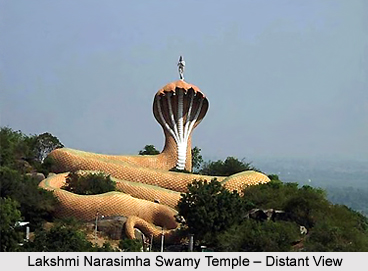 Lakshmi Narasimha Swamy Temple in Andhra Pradesh is one of the religious site, attracted by the people of Andhra Pradesh and other parts of India. As both Vishnu and Siva temples co-exist in Narsimhulapalle, the place is known as "Hari-Hara Kshethram". The mention of this Kshethram is said to have been made in scriptures of Brahma Purana, Brahma Vaivarthana Purana, Bhavishyothara Purana, Vishnu Purana, Shiva Purana and Skanda Purana. As mentioned in the Bhavishyothara Purana, the region where Lakshmi Narasimha Swamy Temple located might have been ruled by the rulers of Nanda Dynasty (424 BC), and consequently the place is known as Nandagiri.
Lakshmi Narasimha Swamy Temple in Andhra Pradesh is one of the religious site, attracted by the people of Andhra Pradesh and other parts of India. As both Vishnu and Siva temples co-exist in Narsimhulapalle, the place is known as "Hari-Hara Kshethram". The mention of this Kshethram is said to have been made in scriptures of Brahma Purana, Brahma Vaivarthana Purana, Bhavishyothara Purana, Vishnu Purana, Shiva Purana and Skanda Purana. As mentioned in the Bhavishyothara Purana, the region where Lakshmi Narasimha Swamy Temple located might have been ruled by the rulers of Nanda Dynasty (424 BC), and consequently the place is known as Nandagiri.
Mythological History of Lakshmi Narasimha Swamy Temple
According to Sage Sootha, in the ancient times, mountains were having wings and they were travelling freely. Once while the Malaya Mountain was travelling from Kanya Kumari to Himalaya Mountains, its four wings fell on the earth. The places where these wings fell are known as Vedagiri, Mangalagiri, Yadagiri and Nandagiri respectively. At the request and prayer of the Malaya Mountain, Lord Vishnu blessed that all these four places will become the places of worship. Vedagiri is called as Vyasa Peetham. Yadagiri is the place where Sage Yaadarshi performed penance. Nandagiri is the place where sage Nanda performed his penance. It is also said that Sankaracharya, an ancient Indian philosopher visited this place and worshipped Lord Lakshmi Narasimha Swamy.
Royal History of Lakshmi Narasimha Swamy Temple
There are various testimonials to state the historical and religious importance of this place. King Gautamiputra Satakarni (241 BC), the son of King Sreemukha of Satavahana dynasty, while going on victory feat from Paithan (Prathistanapuram, present Aurangabad in Maharashtra state), made a halt at Nandagiri village and very much enjoyed the natural beauty of the place and constructed a "Gagana Mandiram" (Sky palace) on the top of the hillock. Later the they constructed temples as per the Advaitha culture on the advice of Vedic scholars. Later on, the rulers of Vemulawada Chalukyas patronized this temple and the Stepped Pyramid type of the Aalaya Gopuram reflects the temple architecture of the Western Chalukyas.
The Veerabhadra Temple, Mallikarjuna Temple and Nanchareesvara Temple, (Somanatha) of Narasimhulapalle village reflect the Kakatiya temple architecture. Therefore, they can be said to belong to the 12th century. As Nandagiri once existed in an ancient mud fort, it is known as Nandagiri-Kotla, and Narsimhulapalle is also called Kotla-Narsimhulapalle.
Before the Mauryas came to power, the Nanda Dynasty who ruled over Magadha were stated to have set up a military camp on the banks of Godavari River known as Nava Nanda Dera, which is now known as Nanded. The Nandas, who had their sway over the region, are believed to have founded this Nandagiri with a mud fort around it and the traces of its moat and walls can be noticed here and there in the twin villages of Nandagiri-Kotla and Kotla-Narsimhulapalle, which once existed within the Kota or Fort.
There are ruins of the fort on the top of the hillock. Two or three stone inscriptions (Shila Shasanas) are found here. It is necessary to bring to light the historical importance of the place as the Archaeology and endowment departments have unfortunately not taken any appropriate action in restoring and renovation of the temple or the fortress on the hillock.





















